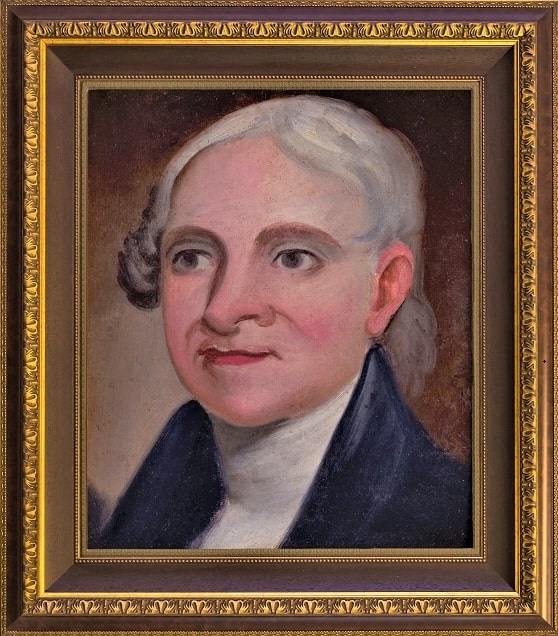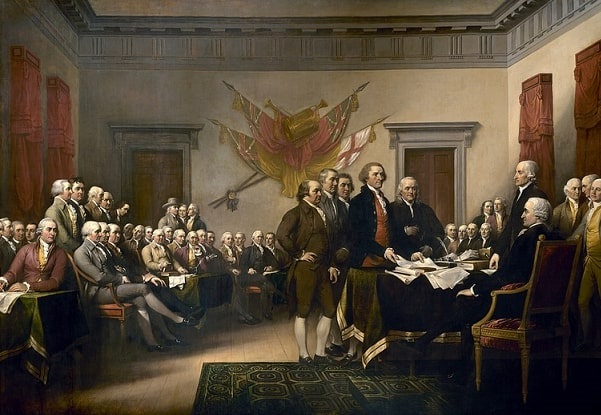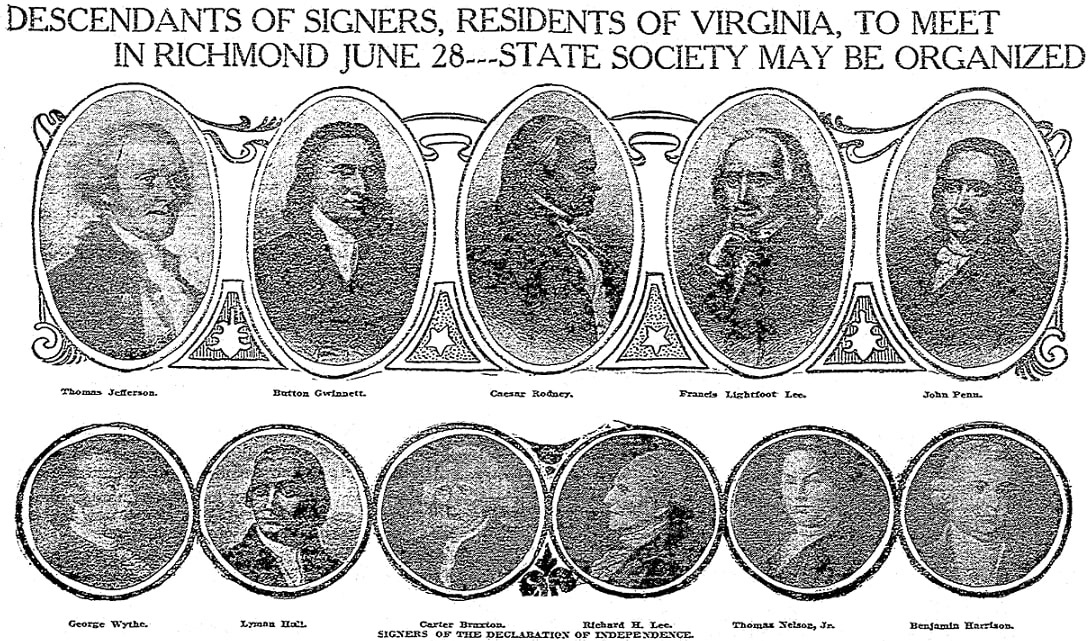Introduction: In this article, Melissa Davenport Berry begins a new series looking at signers of the Declaration of Independence and their descendants, starting with signer Carter Braxton. Melissa is a genealogist who has a blog, AnceStory Archives, and a Facebook group, New England Family Genealogy and History.
In 1910 the Descendants of the Signers of the Declaration of Independence (DSDI) were preparing to host a public gathering at the Jefferson Hotel’s parlor on Franklin Street in Richmond, Virginia.
It was anticipated there would be more than 500 descendants of the signers attending the gathering.

The DSDI society in Virginia was formed in 1907 at the Jamestown Exposition and originated as the “The Order of the Signers of the Declaration of Independence.”
In 1908, on the anniversary of the surrender of Lord Cornwallis, the members of the Order effected a permanent organization in Virginia.
The Richmond Times-Dispatch covered the upcoming public gathering in 1910 and noted the two important objectives of the society.
First, to stimulate a greater interest and attract more members to join the society.
Second, to preserve patriotism by placing a copy of the Declaration of Independence in every school as well as to initiate a yearly celebration on the anniversary day of the official signing of the document. Both students and educators can observe, learn the history, and honor the signers.
Featured in the newspaper clip are the portrait images of some of the signers, along with photographs of their scions. The article begins with portraits of these 11 signers:
- Thomas Jefferson (1743-1826), son of Peter Jefferson and Jane Randolph
- Button Gwinnett (1735-1777), son of Rev. Samuel Gwinnett and Ann Emes
- Caesar Rodney (1728-1784), son of Caesar Rodney and Elizabeth Crawford
- Francis Lightfoot Lee (1734-1797), son of Thomas Lee and Hannah Harrison
- John Penn (1741-1788), son of Moses Penn and Catherine Taylor
- George Wythe (1726-1806), son of Thomas Wythe and Margaret Walker
- Lyman Hall (1724-1790), son of John Hall and Mary Street
- Carter Braxton (1736-1797), son of George Braxton Jr. and of Mary Carter
- Richard Henry Lee (1732-1794), son of Thomas Lee and Hannah Harrison
- Thomas Nelson (1738-1789), son William Nelson and Elizabeth Burwell
- Benjamin Harrison (1726-1791), son of Benjamin Harrison and Anne Carter
Underneath the portraits of the signers are photographs of four of their descendants:
- Henry Lee Valentine, born Katherine Shore Braxton to Henrietta Garlick and William Armistead Braxton Jr.; descended from Carter Braxton and Elizabeth Corbin.
- William Shields McKean, descended from Thomas McKean and Letitia Finney. McKean served as president of the society.
- Captain William Gordon McCabe, born to John Collins McCabe and Elizabeth Sophia Gordon Taylor (daughter of Anna Maria Gordon and James Lewis Taylor, son of signer George Taylor (1716-1781) and Ann Taylor).
- Peter Vivian Daniel Conway, born to Walter Peyton Conway and Margaret Eleanor Daniel; descended through his maternal side from signer Thomas Stone (1743-1787) and his wife Margaret Brown.
Other enthusiasts listed for attendance at the upcoming gathering: Mrs. Henry Lee Watson and Marshall Carter Hall, descended from Carter Braxton; Mrs. John W. Wallace, descended from Thomas Nelson; Mrs. Elizabeth Paul Myers, descended from Benjamin Harrison and his wife Elizabeth Bassett; Thomas Jefferson Randolph, born to William Randolph and Agnes Dillon and a direct descendant of Thomas Jefferson and Martha Wayles.
Many of the society members descended from Carter Braxton, and I found a valuable source on his work. In 1983 Alonzo T. Dill, a Virginia historian, published Carter Braxton, Virginia Signer: A Conservative in Revolt.
Dill lived on the same land as Braxton once did, and had a deep interest in preserving his legacy. A review of the book featured in the Richmond Times-Dispatch praised Dill for his “meticulous research,” asserting he “deserves credit for not only giving Braxton his due, but for taking on the challenge” of writing about such an important figure “with skeletal remains in the historical sources.”
Also noted is the importance of preserving the many Virginians beyond Jefferson and Washington who made their mark in this country’s struggle for freedom.
Here are some of the important details in the book noted by the reviewer:
Great events are seldom determined by the stroke of a pen or by a singular deed.
Rather they are the result of direction coming out of competing ideas and policies usually achieved by the patience, hard work, and abilities of a few men, who, though working in the background, are able to persuade their compatriots to take the right course. [Braxton is one of the unsung heroes in Virginia.]
Very few papers and letters of Braxton survive; many documents were undoubtedly destroyed when his plantation house on the Pamunkey burned in 1776.
Carter Braxton (1736-1797) was not only a true representative of the ruling elite, he was related to most of them. Almost continuously from 1761 to 1790 Braxton served in the colony/state government – in the House of Burgesses, then in the House of Delegates and finally in the Council of State.
He also held various local offices. He served a term in the Continental Congress. Braxton is usually known simply as a signer of the Declaration of Independence.
Like other conservatives, he had tried to prevent what he considered a rash decision for independence, preferring to lay the groundwork first and to be sure of foreign aid. But Braxton bowed to the inevitable and supported independence.
As a member of the Virginia conventions and the Committee of Safety at the beginning of the war, he had advised a more cautious course. Pitted against Patrick Henry initially, he later became a firm ally after the war.
As a legislator, Braxton, though a staunch Anglican, supported disestablishment. More importantly, as chairman of the committee of commerce in the legislature, he was instrumental in Virginia, and called for an interstate convention to deal with navigation and commerce that led to the Constitutional Convention.
Inactive during the ratification contest of 1788, afterward he became a Federalist. In 1786 Braxton moved his huge family from a plantation at the site of present West Point to Richmond. He established residence at what today is the corner of 4th and Broad streets.
Also mentioned in the review: although Braxton made enemies with many, including William Aylett and Robert Morris, he managed to retain the respect of his fellow countrymen.
To be continued…
Explore over 330 years of newspapers and historical records in GenealogyBank. Discover your family story! Start a 7-Day Free Trial
Note on the header image: John Trumbull’s famous 1818 portrait is often identified as a depiction of the Declaration’s signing, but it actually shows the drafting committee presenting its work to the Second Continental Congress on 28 June 1776. Thomas Jefferson, at center, places the document before the president of the Congress, John Hancock. Standing with Jefferson are other members of the drafting committee: John Adams, Roger Sherman, Robert Livingston, and Benjamin Franklin. Less than a week later, on 4 July 1776, the declaration was signed. Note: Not all 56 signers are included in this picture. Credit: Wikimedia Commons.

